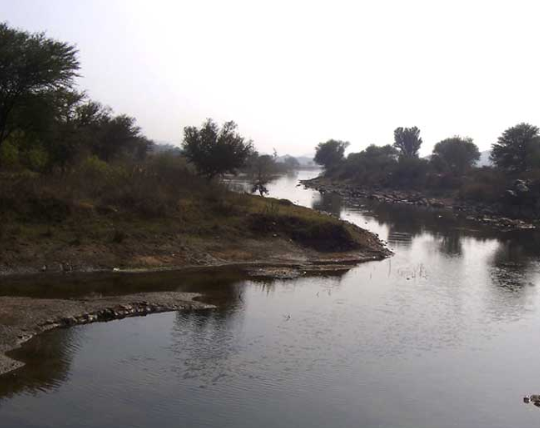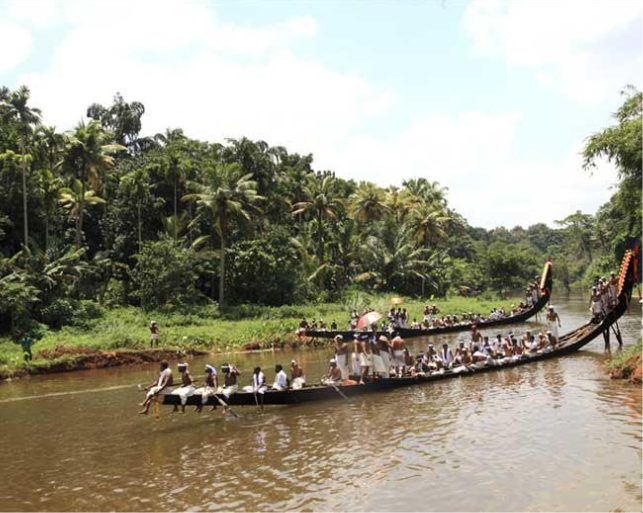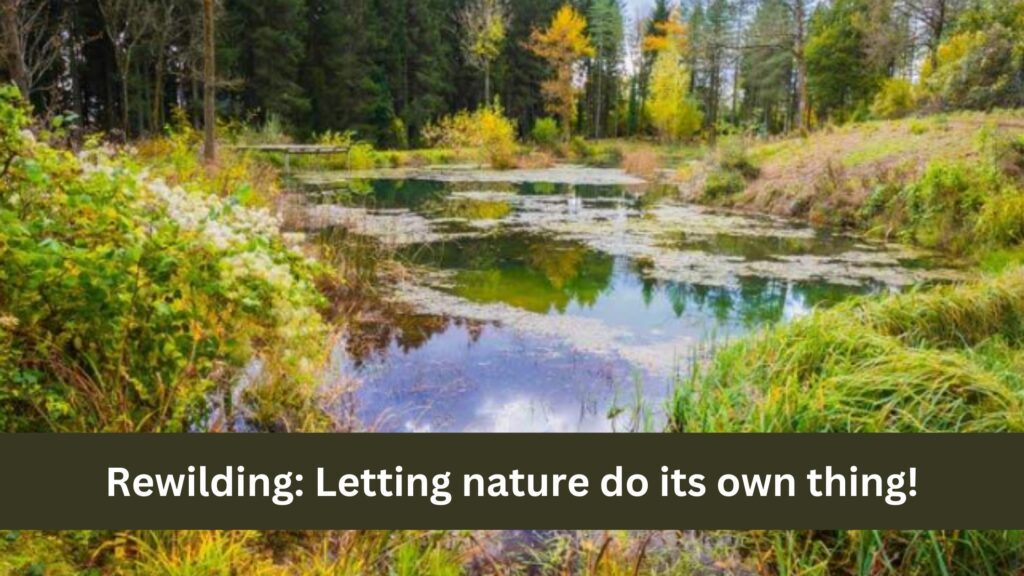Hello everyone, I am Priya and I recently got connected with Itra Foundation, a NGO that works for the benefit of nature, environment and people. Itra Foundation does this by conducting various activities that connects people to this beautiful nature while sharing the knowledge on what this nature offers when we spend time close to it, and also how to protect it. I love this NGO, as I myself was a life science student and had a close connection to plants and animals, later turned to an IT professional. But my profession didn’t impact at all my love for nature and the environment we live in. Hence, I keep exploring on topics around nature to enrich my knowledge and write blogs to share the same, with those who are passionate about nature like me. 🙂
Lately, I came across this term called ‘Re-wilding’, which got me curious as always, and went into exploration of it. If you are equally curious, let us together find out what it is?
What is Re-wilding?
The process of protecting an environment and returning it to its natural state with respect to plants, animals etc that were displaced earlier due to human activities (cultivation, urbanization etc) is ‘Re-wilding’. In simple terms, it is giving the land back to wildlife and wildlife back to the land, whether its plants or animals. It is basically ecological restoration of the land to its ‘original uncultivated state’.
We human beings who are also part of this ecosystem, have been responsible for controlling the natural processes by various activities. Unfortunately, these activities have been threatening the diversity of wildlife, destroying natural resources, and also contributing to the destruction of the environment, leading to whole system suffer. Re-wilding was identified as a solution to overcome this issue. The term was coined by an American environmentalist Dave Foreman, founder of the Rewilding Institute and co-founder of the Wildlands Network (originally Wildlands Project) in 1992, after working on this concept for decades altogether.
Re-wilding was developed as a method to help return important species to environments where they belonged and play a vital role in species diversity and food chains. It also helps combat climate change and reverse species extinction.
Rewilding in India
Even the concept of rewilding in India goes many years back, India started its own independent movement and organization focussing on Rewilding in 2019 with the goal of ecological restoration of degraded landscapes to restore ecosystem and reintroduce lost species. This organization is called “Rewilding India” and is an independent Public Charitable Trust registered in India. The main goal of this organization is as below besides tackling climatic change and sustainable communities :
-
Restore Ecosystems
One of the projects that Government of India is focussed on is PSL (Project Snow Leopard). Government committed to landscape restoration for snow leopard habitat conservation. The Environment minister emphasized that states together with Government of India should resolve to bring up the population of snow leopards in India in the next five years. Under this project, India has identified three large landscapes, namely, Hemis-Spiti across Ladakh and Himachal Pradesh; Nanda Devi – Gangotri in Uttarakhand; and Khangchendzonga – Tawang across Sikkim and Arunachal Pradesh.
-
Protect Biodiversity
Wildlife plays a vital role in maintaining the balance of our ecosystem. It serves various purposes ranging from protecting our biological diversities to maintaining our cultural ethos. Wildlife is indispensable for striking a crucial balance that enables us to live and grow. And hence our government has been taking following steps to protect and conserve the wildlife and its habitat:
- The Wild Life (Protection) Act, 1972 provides for stringent punishment for violation of its provisions. The Act also provides for forfeiture of any equipment, vehicle or weapon that is used for committing wildlife offence(s). Rare and endangered species found in India, like Tiger, Snow Leopard, Great Indian Bustard, Gangetic Dolphin, Dugong, etc. have been listed in the Wild Life (Protection) Act, 1972 thereby providing them highest degree of protection.
- Protected Areas, viz., National Parks, Sanctuaries, Conservation Reserves and Community Reserves have been created in the country covering important habitats to provide better protection to wildlife, including threatened species and their habitat.
- Financial assistance is provided to the State/Union Territory Governments for better protection to wildlife and improvement of habitat.
- The local communities are involved in conservation measures through eco-development activities which help the forest departments in protection of wildlife.
- The Wild Life Crime Control Bureau (WCCB) coordinates with State/UTs and other enforcement agencies to gather intelligence about poaching and unlawful trade in wild animals and animal articles.
- Alerts and advisories were issued by WCCB on poaching and illegal trade of wildlife to the concerned State and Central agencies for preventive action.
History of Rewilding in India due to colonialism!
The need for Rewilding is not recent, but has been there since many years back. Infact, the colonialism in 19th century had a great impact on Indian wildlife and rewilding. The colonial state regarded forests as unproductive and were considered to be wilderness, hence Colonial rulers were told to keep it under cultivation, so that it can yield agricultural products and enhance the income of the state. On the other hand, the British also indiscriminately cut down forest trees for laying roads, ship building and railway sleepers to encourage trade and tourism incomes. This resulted in considerable deforestation in different parts of British India that affected certain species that lived in the forests (extinction of animals).
Benefits of Rewilding
India has overcome colonialism and is a free country now. Our country has been putting lots of efforts to conserve wildlife and its habitat which is benefitting us following ways :
- Growth of crops: Small animals like bees, butterflies help in pollination and hence growing next generation of plants/ fruits etc. Extinction of these small animals will have a huge impact on the food we humans survive on.
- For medicines: Plants are playing a major role in medicine but many animals are important for the production of medicine. The venom from the king cobra is used for the medicine of leprosy.
- For relaxing minds: Its always relaxing to be outdoors with nature comprising fauna and flora. According to the research, the person who watches animals every day and walks in the natural habitat is more stress-free than others.
- To preserve culture: Many trees and animals are considered God and Holy. We need to protect and save our heritage and culture by conserving them.
- For Tourist attraction: Tourism being best source of earnings, if we preserve wildlife and its habitat, it attracts tourists and will be profitable for the country making economy better.
- For ecological activity: Plants and trees are very important for our ecological system as they give oxygen which is most important for humans. It is also balancing the carbon dioxide and oxygen on the planet.
Conservation Projects in India
Since conservation broadly means preservation, protection or restoration, the Indian government has initiated various such projects to protect wildlife in the country. Some of them are :
-
- Project Tiger
- Project Snow Leopard
- Project elephant
- Sea Turtle project
- Crocodile conservation project
- Project Dolphin
- Project Hangul
- India adopts SAWEN (“South Asia Wildlife Enforcement Network”). It is an intergovernmental wildlife support body, which was launched in 2011 at Paro, Bhutan. The main objective of SAWEN is to establish mutual collaboration for wildlife protection. The member countries of SAWEN are Afghanistan, India, Pakistan, Nepal, Bhutan, Bangladesh, Sri Lanka and the Maldives.
Threats to wildlife conservation efforts In India
Despite having above conservation projects in place, there are threats to our fauna and flora all the time that has affected almost 68% of wildlife which is declining day by day. As per a recent report, the wildlife population has decreased by a whopping 68% since 1970. There are various reasons behind it and some of them are as below :
- Overpopulation : Since the human population is rising day by day, it results in an increasing demand for land and other things. The increasing demand for land ultimately results in deforestation which causes habitat loss to these animals.
- Poaching : Illegal trading of animals is increasing rapidly as the parts of animal bodies attract a very high value in the international market.
- Overexploitation : Currently, the diminishing rate of species is very much faster than its recovery. Some species are overtly exploited to meet our human wants, which is a serious threat to our ecosystem.
- Climate change : Climate holds special importance in every aspect. In the past few decades, it is observed that due to global warming, the temperature of Earth is rising, which causes the melting of the glaciers, volcanic eruptions etc. resulting in extinction of various species of the Himalayas.
- Pollution : Pollution is one of the major threats to wildlife. The various types of pollution including air pollution, water pollution, and soil pollution is becoming a serious cause of concern for us.
- Natural or man-made Disaster : If we play with nature, it will play with us too! We have reached a situation wherein we are witnessing deadly disasters almost every year. The unprecedented Covid-19 pandemic is the best example for us, which put the entire world on standstill. Apart from it, earthquakes, floods, and land degradation have become quite common.
Methods of Wildlife conservation
Considering above facts / threats to these wildlife and how they will impact our human lives and entire ecosystem, we humans have to make small steps to protect these for a more sustainable future. Below are listed few methods of wildlife conservation that India is taking currently.
- Habitat management
- Establishment of the protected area
- Rehabilitation of Endangered species
- Captive breeding programme
- Mass education
- Promulgation of laws
Few successful Rewilding projects in India
Arvari River Project

Many a time, we tend to think that a river restoration project is a huge undertaking. But environmentalist Dr. Rajendra Singh, dubbed the waterman of India, proves us wrong. Single-handedly, he has revived several rivers in Rajasthan. For instance, to revive the Arvari river that had remained dry for over 60 years, Dr. Singh, with the help of villagers, built 375 johads (a rainwater storage tank principally used in the state of Haryana and Rajasthan) along the riverbed. Decades later, all his hard work paid off when the Arvari started flowing again. Today, this 45-kilometre-long perennial river flows through the Alwar district of Rajasthan.
Encouraged by his success, Dr. Singh now runs an NGO which has been instrumental in fighting slow bureaucracy and illegal sand mining on riverbeds. Over the years, he and his team have built over 8600 johads and revived five rivers within Rajasthan.
Varattar River Project, India

Varattar, a tributary of the Pamba river, used to be an important river of southern Kerala. In its glory days, this river sustained hundreds of households. But, illegal sand mining and land encroachment killed the Varattar some decades ago. The dead river was further encroached upon by short-sighted real-estate developments.
In a campaign called ‘Varatte aar’ which means ‘let the river flow’ in Malayalam, the people of Kerala decided to revive the Varattar river. Pooling together resources and manpower, several unlawful structures that were built along the river’s path were cleared. Illegal sand mining was also banned. Interestingly, once the path of the river was cleared, and with the onset of the monsoon rains, the river started flowing through its forgotten path once again.
Bisalpur Rewilding Project
The Bisalpur Rewilding Project has been devised to protect & ecologically restore the natural habitat for indigenous flora and fauna in Jodhpur. This unique conservation program currently covers around 350 acres of privately owned land, on the outskirts of the Blue City in Rajasthan. Within the past few years, the team at Bisalpur has re-introduced many native species, including but not limited to over 2000 indigenous trees. What was once an unviable wasteland is slowly but surely transforming into a natural haven, teeming with wildlife.
Now that we have read about few successful re-wilding projects in India, and how they have made a big difference in lives of people around them, we all should be motivated to take few small initiatives in our own ways of re-wilding in our areas. We have also understood now that re-wilded ecosystems can help mitigate climate change by increasing carbon removal from the atmosphere and protect against climate change impacts by reducing soil erosion and flood risk, for example. Rewilded ecosystems can also create socio-economic opportunities for local communities, reduce the effects of and costs associated with environmental hazards (such as flooding), and improve human health and wellbeing by improving access to nature.
Letting nature repair itself costs less than having humans actively managing the landscape, then why not opt for Re-wilding!!





